Summary of the Picos de Europa Lepidoptera Study, 2010
Teresa Farino
26/09/2011 20:30:57
Between February and October 2010 we recorded 118 species of butterfly and 377 macromoths in the Picos de Europa and surrounding area, in the process adding 13 new macromoths to our list for the region.
Posted in: Butterflies and Moths, Endangered Wildlife and Habitats | Cantabria, Castile-Leon | Mainland Spain, Northern Spain
 The Tiger
The Tiger
Atlantarctia tigrina© Teresa FarinoLaunched by Teresa Farino in 1989, this long-term study of the butterflies and macromoths of the Picos de Europa is centred on the valleys of Liébana and Peñarrubia, in the south-eastern corner of the range, extending as far south as the Puerto de Piedrasluengas, in Palencia, and westwards to the Valdeón valley, in León.
In 2010, our surveyors (Teresa Farino, Steve Petty, Marc Botham, John Barkham and Neil Wilding) made 4.737 field observations – 2,669 of butterflies and 2,068 of macromoths – during 113 days/nights, in 105 1km x 1km UTM squares. Between February and October, we detected the presence of 118 species of butterflies and 377 species of macromoths, these figures representing 77% of the 154 butterflies cited to date as being present in the Picos de Europa, and almost 60% of the 667 macromoths recorded since this study began.
Butterflies
As has been the case in recent years, the montane species appear to have been greatly affected by the late snows and low temperatures at altitude that characterised the early summer of 2010. For example, this year we utterly failed to record Mountain Clouded Yellow (Colias phicomone), Lefèbvre’s Ringlet (Erebia lefebvrei) or Silky Ringlet (E. gorge), and encountered Mountain Dappled White (Euchloe simplonia) and Mountain Ringlet (Erebia epiphron) each on just a single occasion. Similarly, Gavarnie Blue (Plebejus pyrenaicus) was registered from only three localities during the course of the summer, with 2010 also providing very few records of Common Brassy Ringlet (Erebia cassioides) and Apollo (Parnassius apollo) as compared to previous years. Once again, the Spanish race of Shepherd’s Fritillary (Boloria pales pyrenemiscens) failed to make an appearance.
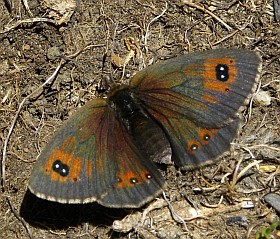 Female Common Brassy Ringlet
Female Common Brassy Ringlet
Erebia cassioides© Teresa FarinoPerhaps for the same reason, very few individuals of a number of species typical of the low and middle altitudes were recorded during 2010, including Silver-spotted Skipper (Hesperia comma), Large Grizzled Skipper (Pyrgus alveus), Rosy Grizzled Skipper (P. onopordi), Green-underside Blue (Glaucopsyche alexis), Purple-shot Copper (Lycaena alciphron), Idas Blue (Plebejus idas), Baton Blue (Pseudophilotes baton), Ilex Hairstreak (Satyrium ilicis), White-letter Hairstreak (S. w-album), Cardinal (Argynnis Pandora), Lesser Marbled Fritillary (Brenthis ino), Great Banded Grayling (Brintesia circe), Large Ringlet (Erebia euryale), Grayling (Hipparchia semele), Esper’s Marbled White (Melanargia russiae), Camberwell Beauty (Nymphalis antiopa), Large Tortoiseshell (N. polychloros), Provence Orange Tip (Anthocharis euphenoides) and Bath White (Pontia daplidice).
More worryingly, several species that we observed consistently during the early years of our study were conspicuous by their absence in 2010: Chequered Skipper (Carterocephalus palaemon; also absent in 2009), Olive Skipper (Pyrgus serratulae), Purple Emperor (Apatura iris), Dusky Heath (Coenonympha dorus; also absent in 2008 and 2009), Chestnut Heath (Coenonympha glycerion), Tree Grayling (Hipparchia statilinus; also absent in 2009) and Southern White Admiral (Limenitis reducta).
Threatened butterflies of Europe in the Picos de Europa
According to the
European Red List of Butterflies, published by van Sway
et al. in 2010, the following butterflies recorded in the Picos de Europa in 2010 are threatened at a European level:
Near Threatened (NT) 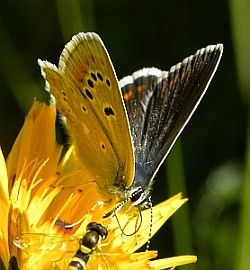 -Female Turquoise Blue
-Female Turquoise Blue
Polyommatus dorylas© Teresa Farino
Tufted Marbled Skipper (Carcharodus flocciferus)
Marbled Skipper (Carcharodus lavatherae)
Lulworth Skipper (Thymelicus acteon)
Dusky Large Blue (Phengaris nausithous)
Turquoise Blue (Polyommatus dorylas)
Rock Grayling (Hipparchia hermione)
Tree Grayling (Hipparchia statilinus)
Apollo (Parnassius apollo)
Vulnerable (VU)
Woodland Brown (Lopinga achine)
In addition, several Picos butterflies are listed on the EU Habitats Directive:
Dusky Large Blue, Woodland Brown and Apollo are registered on Annexes II and IV, and Marsh Fritillary (Euphydryas aurinia)is on Annex II.
According to Verdu, J. R. y Galante, E., in Invertebrados Amenazados de España (2010), both Dusky Large Blue and Woodland Brown are listed as Vulnerable at a national level.
Notable butterfly records in 2010
• populations of the rather scarce Marbled Skipper (Carcharodus lavatherae) were recorded from seven distinct localities, the majority in Cantabria (S), and all from limestone regions, at altitudes ranging from just 420 to 1350m;
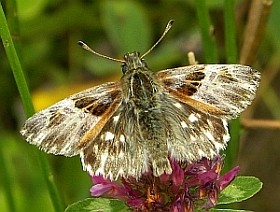 Tufted Marbled Skipper
Tufted Marbled Skipper
Carcharodus flocciferus© Teresa Farino• we recorded a single individual of Tufted Marbled Skipper (Carcharodus flocciferus) in the same meadow near Pesaguero (S) as in 2009, with a new locality discovered to the north of Enterrías (S) in September;
• a second record of Southern Marbled Skipper (Carcharodus baeticus) near Tudes (S), originally detected in this same locality by our study in 2007;
• good populations of Lulworth Skipper (Thymelicus acteon; Near Threatened at a European level) in 2010, as is usually the case in Liébana, with records pertaining to 13 1km x 1km squares;
• several new colonies of Large Chequered Skipper (Heteropterus morpheus) were discovered, the majority originating in the region of Peñarrubia (S) – five new 1km x 1km squares , although the species was not located in the Urdón area in 2010;
• just two citations of Dusky Large Blue (Phengaris nausithous) in 2010, both coming from the León sector of the Picos de Europa, with low abundance of individuals on each occasion;
• two records of Sloe Hairstreak (Satyrium acaciae) – a species recorded only rarely in the Picos de Europa, both from Mediterranean habitats in Liébana (S); 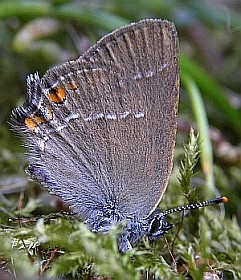 Sloe Hairstreak
Sloe Hairstreak
Satyrium acaciae© Teresa Farino
• two new colonies of Brown Hairstreak (Thecla betulae) for our study, both from Peñarrubia, with this rather scarce butterfly also once again recorded in the Pesaguero (S) area;
• first record for our study of a female of Lesser Purple Emperor (Apatura ilia; see previous blog). Although the species had previously been cited in the Picos de Europa by Gómez-Bustillo, M. R. in 1971, our record would appear to be the first for the province of Cantabria;
• we once again recorded several individuals of Bog Fritillary (Boloria eunomia) near San Glorio (LE), as well as a singleton of this species near Piedrasluengas (P), where it had not been seen since 2003.
• 2010 saw good populations of Marsh Fritillary (Euphydryas aurinia; Annex II) on the wing, as is the norm in Liébana, with records coming from 13 1km x 1km squares in Cantabria;
• in addition, 2010 was the best year for Woodland Brown (Lopinga achine) in Liébana (S) since our study began, with at least 15 individuals recorded on 5 July.
• populations of False Heath Fritillary (Melitaea diamina) were fairly abundant in 2010, but this species continues to be restricted to limestone habitats in the eastern part of our study area.
Macromoths
We are extremely grateful to professional entomologist Colin W. Plant – the head of this project – for the identification of many problematic species encountered during the 2010 season. As a direct result, we added no fewer than 13 new macromoths to our list for the Picos de Europa, details of which are given below.
New Species of Macromoths for the Picos de Europa Lepidoptera Study in 2010
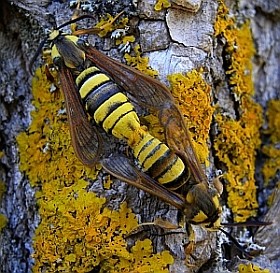 Hornet Clearwing
Hornet Clearwing
Sesia apiformis© Teresa FarinoSesiidaeSesia apiformis (Hornet Clearing/Hornet Moth)
Geometridae
Idaea humiliata (Isle of Wight Wave)
Idaea macilentaria (Scalloped Wave)
Menophra nycthemeraria (Nocturnal Umber)
Peribatodes ilicarius; (Holm Oak/Lydd Beauty)
Lasiocampidae
Eriogaster catax (Eastern Eggar)
Noctuidae
Acronicta cuspis (= Triaena cuspis; Large Dagger)
Apamea unanimis (Small Clouded Brindle)
Autophila cataphanes
Dichagyris candelisequa
Lithophane socia (= L. hepatica; Pale Pinion)
Nycteola revayana (Oak Nycteoline)
Yigoga forcipula
2010 moth highlights
• our record of a single male Eastern Eggar (Eriogaster catax) in Pesaguero (S) in October was without a doubt the most interesting find of the season (see previous blog). This species is included in both Annexes II and IV of the European Habitats Directive, but curiously is not listed in the Catálogo Regional de Especies Amenazadas de Cantabria, despite the fact that there is an old record from Fuente Dé. Our record would appear to be only the third for the province of Cantabria;
 Dichagyris candelisequa© Teresa Farino• we located a good colony of the magnificent Hornet Clearwing (Sesia apiformis) near Piedrasluengas (P), although it seems likely that many of the poplars it inhabits will be felled in the course of a proposed road improvements scheme;
Dichagyris candelisequa© Teresa Farino• we located a good colony of the magnificent Hornet Clearwing (Sesia apiformis) near Piedrasluengas (P), although it seems likely that many of the poplars it inhabits will be felled in the course of a proposed road improvements scheme;
• according to Geometridae Ibericae (Redondo et al., 2009), our records of Isle of Wight Wave (Idaea humiliata), Scalloped Wave (I. macilentaria), Nocturnal Umber (Menophra nycthemeraria) and Holm Oak/Lydd Beauty (Peribatodes ilicarius) are all new for the province of Cantabria;
• according to Redondo, V. et al., (2010) Las Mariposas de España Peninsular, the noctuid Autophila cataphanes displays a marked eastern and southern distribution in the Iberia Peninsula, preferring dry habitats with Mediterranean vegetation, so our record for Pesaguero (S) is undoubtedly an interesting one;.
• it is also worth mentioning that, as in almost all the preceding years of our study, we recorded Spanish Tiger (Hyphoraia dejeani; Arctiidae) and Spanish Puss-moth (Cerura iberica; Notodontidae) in some abundance in Pesaguero (S, both of which are Iberian endemics.
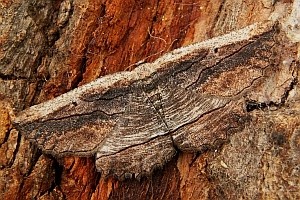 Nocturnal Umber
Nocturnal Umber
Menophra nycthemeraria© Teresa FarinoIn conclusion, the results of our 2010 study have confirmed once again that the Picos de Europa holds diverse and abundant communities of both diurnal and nocturnal lepidoptera, including important populations of several species that are threatened at a European and national level. There is, however, undoubtedly still much more to discover here, so Teresa would be delighted to hear from anyone who would like to contribute records to the study.
Nevertheless, it should also be noted that changes in the traditional livestock-rearing regime of these mountains are significantly affecting the semi-natural habitats of the region, and are – not surprisingly – having a negative impact on butterfly and moth populations, particularly the rarer and more endangered species.
Don’t forget that in Spain it is ILLEGAL to use a butterfly net or moth trap without a permit from the relevant authorities, even if you do not take specimens.
Related Information:
Details of Teresa's annual butterflies and moths holiday in the Picos de Europa]
Summary of the Picos de Europa Lepidoptera Study, 2008
Summary of the Picos de Europa Lepidoptera Study, 2009
Read more blog posts